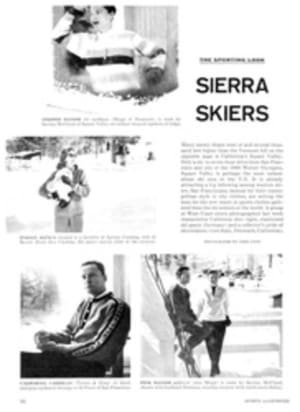
YUCATAN: WEEKEND BY AIR
Yucatàn is a Lollobrigidan bulge in the Central American silhouette, a state of Mexico possessed of the singular independent attitudes of Texas, carpeted with a low but dense tangle of tropical greenery and studded with the ruins of the Mayans that are no less awesome than the works of the early Egyptians.
Barefoot Mayan maidens pad the highways with pails of corn on their heads. Mayan witch doctors can still make a love potion out of powdered hummingbird's heart. Yucatecans raise henequen and bees. The henequen goes for rope, and the bees buzz the yellow tah flower in winter and the white dze-dzel-che in summer and give honey. When work is done the descendants of the Mayans sling hammocks under the sour orange trees. The rest is good for the soul, and the sour orange is good for the liver, the stomach and, besides, it thins the blood.
Even though it was near by, civilization until recently barely caused this land of honey, hammocks and henequen to stir from the somnolence in which it dozed since the decline of the Mayan Empire in the 11th Century A.D. It took the drone of the airplane these last 10 years to shake it almost fully awake. Now Pan American, winging down dead south from New Orleans, bisects the Gulf of Mexico four times weekly in a flat two hours and a half. Another PAA route skims over from Miami in three hours and 40 minutes, and Mexicana de Aviación, Pan Am's Mexican affiliate, comes in from Mexico City daily in two hours and a half.
What the pioneering tourist availing himself of these speedy expeditions will discover is a planned system for climbing through the ruins of a remarkable North American civilization which flourished during the European Dark Ages; a pair of handsome hotels in which to stay meanwhile; and some rare opportunities to hunt jaguar, shoot duck and catch game fish.
The Hotel Mérida in Mérida, capital of the state of Yucatàn, is not exactly the Waldorf, but it has air-conditioned rooms, a swimming pool and a restaurant offering such local délicatesse as pargo and baby octopus swimming in Waterman's blue-black. Some street corners in Mérida, otherwise unnamed, are marked by the figure of a bull, a jaguar or an elephant and are known by these insignia. Rickety cal√®ches pulled by pygmy-sized horses bred by the Spaniards for easy ocean shipment are still the local hacks, and herdsmen roam the residential districts with their goats, which they milk right at the front door. Anybody eager to import some of the pleasures of Yucatecan life can pick up a hammock at the Penitentiary Juarez, where the inhabitants spend their hitches making hitches. They cost about $15 U.S. if you don't bother to dicker, but from the looks of the jailers a man putting up an argument could probably swing for less.
From Mérida the roads branch out in two directions, to Uxmal and to Chichén Ità. An hour out of Mérida, deep in a vast leaf-green sea of foliage, is the archaeological island of Uxmal, and alongside it the new Hacienda Uxmal. The Hacienda, with 22 rooms all with bath, is a delight of an inn fraught with Spanish décor and bursting with tropical fernery. It has been assembled like a quadrangle, with polished tile walks bordering the center court. A cool pool is surrounded with a carpet of dichondra grass. Swallows that have nests in the ruins come to circle it; white cranes drink in it. And all around it bright purple amor seco grows in rashes, and bougainvillaea vines climb the trellises. There is lavender Moses-in-the-bulrushes, flamboyant, screaming red in season, and banana trees and wild bojon. A papaya tree three months after its planting is round-shouldered with fruit already big as watermelon.
The guitars strum at lunchtime and at dinner, and the waitresses, in a sort of white Mother Hubbard with lace and embroidery top and bottom, dance the jarana with the houseboys. Guests sip the Uxmal cocktail, which is loaded with xtabentun, a liqueur made of a white flower, or drink the good Yucatecan beer. The Hacienda imports soft tiny shrimp and lobster tails from Campeche, wild duck from Progreso and serves them with French-fried chayote, which looks like an elongated green pear.
Not 10 minutes down the road is the dead city of Uxmal with its Temple of the Dwarf, a 70° pyramid with steps leading to the top; the Palace of the Governor, built of 20,000 hand-cut stones, which housed the Xiu family, rulers of a race that knew astronomy, hieroglyphics and architecture.
For those who want to probe farther there are day trips over rough country roads by Model T—the Hacienda will pack a box lunch and ice—leaving at dawn for the drive to Sayil and then on to Labnà, which has an impressive monumental arch. Guides and guiding at Uxmal are in the hands of Francisco Gutierrez, and lest anyone worry about English, the dining, the décor and the inn itself are run by Francisco's wife Jetta, once a tourist out of Cleveland.
To get to Chichén Ità one has to drive back to Mérida, a 45-mile journey across a green plain that stretches into infinity. Now and then there is the oasis of a hacienda, with its ordered rows of henequen and nearby a village with mud and stick huts caked with white plaster and covered by roofs of thatch. Old sunbeaten cathedrals with bells hung in belfry arches bleach in the sun; buzzards, protected by law, wheel in the sky searching for a moribund meal; and windmills, all made in Chicago, pump up the water from the underground wells and rivers.
The Mayaland Hotel, which adjoins the ruins of Chichén Ità, 85 miles and two hours from Mérida, was built in 1930 when there was no road. Travelers, frequently lured off the Ward Line's boats that put into Progreso, came by train to Dzitas, then bumped over the last two miles in Model T Fords. The Carnegie Institution had started work uncovering Chichén in 1924, and when the road was brought in, 16 years later, the tourists flocked to see what marvels the archaeologists had uncovered and patched together.
For one thing, there was the ball court where seven players on a side, all of them priests, cavorted on a court 200 feet long and 90 feet wide. Elbows, feet, hips and knees could be used to coax the ball through a narrow basket hung on each side wall. It was religion as well as sport and the Mayans played for keeps. The captain of the losers lost his head as well as the game.
The Temple of the Jaguars is a tortuous climb, but inside the adventurous (and the energetic) will find a red stone jaguar with jade eyes. A quarter of a mile down a jungle road is the Sacred Well, a watery pit into which Mayan virgins were sacrificed to woo the god who would bring rain. When it was dredged at the turn of the century the well gave up pieces of jade, jewelry of copper and gold, and human skulls, some of which are now in Harvard's Peabody Museum.
Spang among the ruins, the Mayaland Hotel's 37 rooms include several thatched-roof cottages, Mayan style. It charges $15 a day per person, American plan, and the meals can include chicken wrapped in banana leaf, eagle cake, eggplant pie and other temptations of the Indians. The Mayaland and the Hacienda Uxmal, as well as 48 acres on which the ruins of Chichén Ità repose, are owned by Fernando Barbachano, and his travel agency operates package tours to all ruins.
Cozumel calling
Barbachano is also developing the once decrepit hacienda at Chichén where the Carnegie archaeologists lived. It will have 18 guest rooms, a pool, riding horses and a more resorty air than the Mayaland, which runs its house strictly for ruin gazers. Another Barbachano project is a 20-room hotel on Cozumel Island, whither a DC-3 drones out every day in an hour and 10 minutes from Mérida, landing on a U.S.-built jet air base. There is snorkeling, fishing for marlin, sail, barracuda and tarpon (bring along your own tackle), sunning on a 10-mile strip of sand and treasure-hunting in town. Cozumel is a free port.
Expeditions can be arranged for wild boar, wild turkey and even monkey. There are night hunts in 15-foot canoes for alligator, sorties in search of jungle deer, which from hearsay are every bit as big as chihuahuas. As a guide was saying the other day, "We kill them like rabbits here." There is no season on cats, but you've got to give the man 10 days on safari in the jungles of Quintana Roo, flying up from Mérida to airstrips hacked out of the bush. The duck hunting season runs from November to March. Hunters work out of small boats in the inland channels on either side of Progreso, 20 miles from Mérida, and the target is widgeons, canvasbacks, pintails, mallards and, as far as I can tell, everything but Long Island duckling.
PHOTO
UNAWED BY HISTORY, a small boy visiting Uxmal lines a hot one across the crumbling courtyard of the Palace of the Governor. Even in Yucatan beisbol is a universal game.
ILLUSTRATION
"That's the way it goes. One man's meat is another man's poison."

